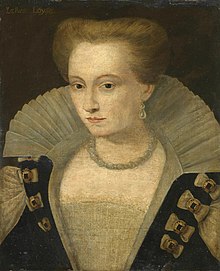Louise of Lorraine: Difference between revisions
No edit summary |
No edit summary |
||
| Line 10: | Line 10: | ||
Upon the death of [[Charles IX of France]], and Henry's accession as Henry III, Louise was not initially considered to be Queen - Henry intended to procure Marie a divorce from her husband and marry her himself. Marie died of a lung infection, however, and after a period of deep mourning, he decided - against the advice of his mother and his councillors - to marry Louise, sending his ''mignon'', Cheverney, to inform the girl and her family (who responded to the news by bowing and curtsying to her with embarrassment). |
Upon the death of [[Charles IX of France]], and Henry's accession as Henry III, Louise was not initially considered to be Queen - Henry intended to procure Marie a divorce from her husband and marry her himself. Marie died of a lung infection, however, and after a period of deep mourning, he decided - against the advice of his mother and his councillors - to marry Louise, sending his ''mignon'', Cheverney, to inform the girl and her family (who responded to the news by bowing and curtsying to her with embarrassment). |
||
[[Image:Clouet Louise Lorraine.JPG|thumb|Portrait of Louise de Lorraine-Vaudémont by [[François Clouet]]]] |
|||
The wedding took place on [[13 February]] [[1575]], two days after Henry's coronation. It was marked, typically for her husband, by a strong element of farce, the King not only designing her dresses and costumes himself, but delaying the wedding – scheduled for the morning – until the evening because he had spent several hours personally dressing her hair. The couple were finally married |
The wedding took place on [[13 February]] [[1575]], two days after Henry's coronation. It was marked, typically for her husband, by a strong element of farce, the King not only designing her dresses and costumes himself, but delaying the wedding – scheduled for the morning – until the evening because he had spent several hours personally dressing her hair. The couple were finally married |
||
at the [[Notre-Dame de Reims|Cathedral of Reims]] by Cardinal Charles de Bourbon that evening. |
at the [[Notre-Dame de Reims|Cathedral of Reims]] by Cardinal Charles de Bourbon that evening. |
||
Revision as of 09:11, 22 September 2007

Louise de Lorraine-Vaudémont (April 30, 1553 - January 29, 1601) was a member of the House of Lorraine who became Queen consort of France from 1575 until 1589.
Born in Nomeny in the Lorraine region of France, she was the daughter of Nicholas, Duke of Mercoeur and Margaret of Egmont.
Her childhood was unhappy; largely unloved by her father and step-mother, she was expected to keep out of the way of her family. This upbringing would result in her being quiet and dutiful as an adult. She was also very pious.
She first caught the eye of her future husband, Henry, Duke of Anjou, in 1574. Recently elected King of Poland, he was paying a visit to her uncle, the Duke of Lorraine (married to Henry's sister, Claude) on his way to his new kingdom, and caught sight of Louise whilst he was there. Henry was attracted to Louise, who was not only blonde, attractive, and sweet-natured, but who also resembled the Princess of Conde, Marie de Cleves, with whom Henry was desperately infatuated. He remembered Louise after he left France.
Upon the death of Charles IX of France, and Henry's accession as Henry III, Louise was not initially considered to be Queen - Henry intended to procure Marie a divorce from her husband and marry her himself. Marie died of a lung infection, however, and after a period of deep mourning, he decided - against the advice of his mother and his councillors - to marry Louise, sending his mignon, Cheverney, to inform the girl and her family (who responded to the news by bowing and curtsying to her with embarrassment).

The wedding took place on 13 February 1575, two days after Henry's coronation. It was marked, typically for her husband, by a strong element of farce, the King not only designing her dresses and costumes himself, but delaying the wedding – scheduled for the morning – until the evening because he had spent several hours personally dressing her hair. The couple were finally married at the Cathedral of Reims by Cardinal Charles de Bourbon that evening.
Although Louise worshipped her husband, who in response fussed over her, the marriage failed to produce children (she is believed to have suffered a miscarriage in the Spring of 1576; if so, it would possibly have prevented the couple from producing further children), and consequently - the heir-presumptive being by the end of the reign the controversial Henry of Navarre - it was unhappy. The Queen as a result became thin, suffered fits of depression, and with her husband made pious offerings and pilgrimages to plead for sons.
In 1589 Queen Louise inherited Château de Chenonceau and was staying there at the time her husband was assassinated on 2 August. She fell into a state of depression and spent the remainder of her days in mourning clothes amidst somber tapestries.
Queen Louise died in Moulins, Allier in 1601 and was buried at the Convent of the Capuchins. In 1817 her remains were reinterred next to her husband in the Saint Denis Basilica.
Sources
Frieda, Leonie, Catherine de Medici
